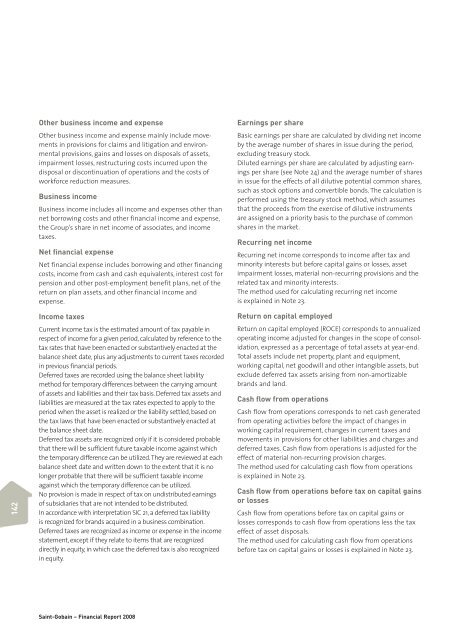sain t-gobain annu al report 2008 annual report
sain t-gobain annu al report 2008 annual report
sain t-gobain annu al report 2008 annual report
You also want an ePaper? Increase the reach of your titles
YUMPU automatically turns print PDFs into web optimized ePapers that Google loves.
142<br />
Other business income and expense<br />
Other business income and expense mainly include movements<br />
in provisions for claims and litigation and environment<strong>al</strong><br />
provisions, gains and losses on dispos<strong>al</strong>s of assets,<br />
impairment losses, restructuring costs incurred upon the<br />
dispos<strong>al</strong> or discontinuation of operations and the costs of<br />
workforce reduction measures.<br />
Business income<br />
Business income includes <strong>al</strong>l income and expenses other than<br />
net borrowing costs and other financi<strong>al</strong> income and expense,<br />
the Group’s share in net income of associates, and income<br />
taxes.<br />
Net financi<strong>al</strong> expense<br />
Net financi<strong>al</strong> expense includes borrowing and other financing<br />
costs, income from cash and cash equiv<strong>al</strong>ents, interest cost for<br />
pension and other post-employment benefit plans, net of the<br />
return on plan assets, and other financi<strong>al</strong> income and<br />
expense.<br />
Income taxes<br />
Current income tax is the estimated amount of tax payable in<br />
respect of income for a given period, c<strong>al</strong>culated by reference to the<br />
tax rates that have been enacted or substantively enacted at the<br />
b<strong>al</strong>ance sheet date, plus any adjustments to current taxes recorded<br />
in previous financi<strong>al</strong> periods.<br />
Deferred taxes are recorded using the b<strong>al</strong>ance sheet liability<br />
method for temporary differences between the carrying amount<br />
of assets and liabilities and their tax basis. Deferred tax assets and<br />
liabilities are measured at the tax rates expected to apply to the<br />
period when the asset is re<strong>al</strong>ized or the liability settled, based on<br />
the tax laws that have been enacted or substantively enacted at<br />
the b<strong>al</strong>ance sheet date.<br />
Deferred tax assets are recognized only if it is considered probable<br />
that there will be sufficient future taxable income against which<br />
the temporary difference can be utilized. They are reviewed at each<br />
b<strong>al</strong>ance sheet date and written down to the extent that it is no<br />
longer probable that there will be sufficient taxable income<br />
against which the temporary difference can be utilized.<br />
No provision is made in respect of tax on undistributed earnings<br />
of subsidiaries that are not intended to be distributed.<br />
In accordance with interpretation SIC 21, a deferred tax liability<br />
is recognized for brands acquired in a business combination.<br />
Deferred taxes are recognized as income or expense in the income<br />
statement, except if they relate to items that are recognized<br />
directly in equity, in which case the deferred tax is <strong>al</strong>so recognized<br />
in equity.<br />
Earnings per share<br />
Basic earnings per share are c<strong>al</strong>culated by dividing net income<br />
by the average number of shares in issue during the period,<br />
excluding treasury stock.<br />
Diluted earnings per share are c<strong>al</strong>culated by adjusting earnings<br />
per share (see Note 24) and the average number of shares<br />
in issue for the effects of <strong>al</strong>l dilutive potenti<strong>al</strong> common shares,<br />
such as stock options and convertible bonds. The c<strong>al</strong>culation is<br />
performed using the treasury stock method, which assumes<br />
that the proceeds from the exercise of dilutive instruments<br />
are assigned on a priority basis to the purchase of common<br />
shares in the market.<br />
Recurring net income<br />
Recurring net income corresponds to income after tax and<br />
minority interests but before capit<strong>al</strong> gains or losses, asset<br />
impairment losses, materi<strong>al</strong> non-recurring provisions and the<br />
related tax and minority interests.<br />
The method used for c<strong>al</strong>culating recurring net income<br />
is explained in Note 23.<br />
Return on capit<strong>al</strong> employed<br />
Return on capit<strong>al</strong> employed (ROCE) corresponds to <strong>annu</strong><strong>al</strong>ized<br />
operating income adjusted for changes in the scope of consolidation,<br />
expressed as a percentage of tot<strong>al</strong> assets at year-end.<br />
Tot<strong>al</strong> assets include net property, plant and equipment,<br />
working capit<strong>al</strong>, net goodwill and other intangible assets, but<br />
exclude deferred tax assets arising from non-amortizable<br />
brands and land.<br />
Cash flow from operations<br />
Cash flow from operations corresponds to net cash generated<br />
from operating activities before the impact of changes in<br />
working capit<strong>al</strong> requirement, changes in current taxes and<br />
movements in provisions for other liabilities and charges and<br />
deferred taxes. Cash flow from operations is adjusted for the<br />
effect of materi<strong>al</strong> non-recurring provision charges.<br />
The method used for c<strong>al</strong>culating cash flow from operations<br />
is explained in Note 23.<br />
Cash flow from operations before tax on capit<strong>al</strong> gains<br />
or losses<br />
Cash flow from operations before tax on capit<strong>al</strong> gains or<br />
losses corresponds to cash flow from operations less the tax<br />
effect of asset dispos<strong>al</strong>s.<br />
The method used for c<strong>al</strong>culating cash flow from operations<br />
before tax on capit<strong>al</strong> gains or losses is explained in Note 23.<br />
Saint-Gobain – Financi<strong>al</strong> Report <strong>2008</strong>

















